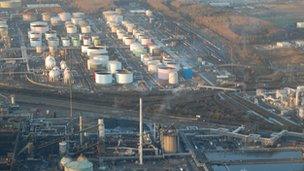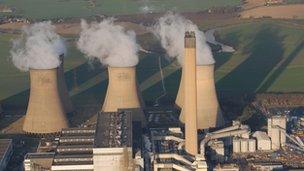Carbon dioxide from industry could be buried offshore
- Published
Dr Stephen Brown, director at CO2 Sense, gave the BBC a birds eye tour of the Yorkshire and Humber region's proposed carbon capture sites
Hiring a helicopter to hover above some of the Europe's largest carbon dioxide emitters seems an odd way to go about promoting green energy.
In the shadow of the vast cooling towers stand a few small turbines, generating a tiny fraction of the power emerging from their concrete neighbours.
But, for once, it isn't the turbines but the coal plants themselves that are on show.
According to CO2 Sense, a not-for-profit company which works to support clean energy projects in the area, the Yorkshire and Humber region is one of Europe's biggest emitters of carbon dioxide.
It is home to some of the UK's largest power stations.
Together, Ferrybridge, Drax and Eggborough provide more than 10% of our electricity but emit some 30 million tonnes of CO2, an odourless and colourless gas, every year.
Chief Scientific Officer, David MacKay looks at the various energy options available to the UK
Add to that two of the UK's larger refineries - Total's Lindsay oil and Conoco Phillip's Immingham - and one of our largest steel mills, Tata Steel's Scunthorpe plant.
The entire cluster puts out a total of 60 million tonnes of CO2 more than double the next biggest emitting region in the UK, along the Thames in Greater London.
"What we're in here is one of the Europe's big energy and climate change hotspots," says Dr Stephen Brown, director of carbon capture and storage at CO2 Sense.
It means that in this region, thousands of jobs depend on industries whose emissions are set to be taxed and regulated ever more heavily over the next decade.
Some may be forced to close, others to move abroad.
Keeping the lights on
To Dr Brown, however, the cluster presents an unusual opportunity.
The more industries releasing carbon dioxide in one place, the more potential customers there are for a plan to capture the greenhouse gas and bury it far out under the North Sea.
Carbon Capture and Storage (CCS) for electricity generation has not yet been carried out commercially and at scale anywhere.
But, for the UK government, along with many others, it is almost essential.
Many of the UK's coal and nuclear plants are due to be de-commissioned over the next 10 years as a result of old age or because they do not comply with new emissions regulations.

Big industry could also benefit from CCS
New nuclear plants have not even been started yet, while offshore wind is running behind schedule.
And the government has promised to completely de-carbonise electricity generation by 2050 - so any new gas or coal plants will be needing their carbon dioxide captured and stored.
"If you want to achieve the sort of carbon reductions we're talking about... either we can't do it without CCS or it would be much more expensive," says Malcolm Grimston, associate fellow at the Oxford Institute of Energy Studies.
The plan
Early efforts in the UK and around the world have so far yielded little.
The first UK project was meant to be under way at Longannet in Scotland. But the Treasury withdrew £1bn of support funding from the project when it became clear that it would not be enough to get the plant built.
Instead a range of projects are now turning to an EU competition - NER 300 - for money they hope will be matched by governments.
Three of them come from the Humber region. The owners of the giant coal plant Drax are joined by some less conventional proposals.
Private equity backed 2Co wants to build a new coal plant above the Hatfield coal mine and pump the gas to North Sea oil fields where it can be used for enhanced oil recovery.
The idea is that by pushing carbon dioxide in, you can get more oil out - so making money for the taxpayer.
Belgian firm C-Gen wants to build a gas-fired power station with carbon capture in Killingholme, North Lincolnshire.
And at Ferrybridge, Scottish and Southern Energy are to start a small pilot plant shortly, though they are not seeking funding from the NER 300 competition.
The pipe
All the proposals envisage a giant pipe starting with a coal plant, but then collecting carbon dioxide from anyone who will capture it before bringing it out to be buried under the sea bed.

Capturing the colourless gas from the smokestack of existing coal plants could reduce their efficiency.
The project is likely to be run by the National Grid and is designed to prevent high carbon industry leaving to avoid paying for their emissions - so called carbon leakage.
"There is the issue of carbon leakage for companies such as steel firms that compete on a global basis," admits Tata's Dr Bruce Adderly.
Tata is keen for the pipe to be built, but hasn't yet offered to pay for it.
One way to force coal and steel plants to pay would be to make carbon so expensive that paying to bury it makes sense.
But that may not work.
"The problem with that is you push industry into an uneconomic state and you would lose jobs - the last thing we want to do is lose our industry and then try and decarbonise something that doesn't exist," says Jim Ward, head of CCS at the National Grid.
Funding shortfall
Instead, the coal plants in the region are bidding for European and UK government funding.
But the economic sands have shifted beneath them.
The EU funding comes in the form of carbon credits, which they can sell.
However, the value of those credits has fallen significantly since emissions reduced around Europe during the economic downturn.
"The recession has meant the price of carbon has plummeted, and means that anyone who has any money to do anything doesn't want to - a lot of these projects are not going to happen," says Mr Grimston.
Projects will be built, he says, and the cost of doing so will fall - but first there must be a negotiation with government.
And not only is CCS expensive to build, unlike conventional coal and gas, it is also expensive to run, unlike wind and nuclear.
Currently separating out the CO2 reduces the efficiency of the plant by about 20-30%, as you need to burn more coal or gas to produce the same power.
"You can't compete with anyone," says Mr Grimston.
From his perch in a helicopter above one of Europe's most polluting regions, these concerns don't seem to deter Dr Brown.
Enhanced oil recovery, for example, could yet help the sums to add up, or the cost of carbon could rise, increasing the subsidy.
For Yorkshire and the Humber, along with other industrial parts of the UK, it may well be CCS or bust.